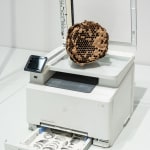Nicolás Lamas
Traces of activity, 2021
Printer, wasp nest, paper
44 x 63 x 54 cm
17 3/8 x 24 3/4 x 21 1/4 inches
17 3/8 x 24 3/4 x 21 1/4 inches
Copyright The Artist
Weitere Abbildungen
-
(View a larger image of thumbnail 1
)

-
(View a larger image of thumbnail 2
)

-
(View a larger image of thumbnail 3
)

-
(View a larger image of thumbnail 4
)

-
(View a larger image of thumbnail 5
)

-
(View a larger image of thumbnail 6
)

-
(View a larger image of thumbnail 7
)

-
(View a larger image of thumbnail 8
)

Die Skulpturen von Nicolas Lamas, die sich aus organischen Elementen, präzise gefertigten Strukturen und gebrauchten Alltagsgegenständen zusammensetzen wirken wie hybride Artefakte, die verschiedene Zeitlinien verbinden. Sie spiegeln das Interesse des...
Die Skulpturen von Nicolas Lamas, die sich aus organischen Elementen, präzise gefertigten Strukturen und gebrauchten Alltagsgegenständen zusammensetzen wirken wie hybride Artefakte, die verschiedene Zeitlinien verbinden. Sie spiegeln das Interesse des Künstlers an Archäologie und der Entstehung technischer Errungenschaften über Jahrtausende hinweg. „Technologie entwickelt sich weiter und blickt in die Zukunft, während die Archäologie eine Disziplin ist, die per Definition ständig Daten aus der Vergangenheit sammelt, und zwar anhand der materiellen Spuren, die unsere Vorfahren hinterlassen haben. Manchmal vergessen wir jedoch, dass sich sowohl die Vergangenheit als auch die Zukunft ständig weiterentwickeln.“ Die Assemblagen eröffnen so Dialoge über Vergänglichkeit, Hybridität und die Trennung von Kultur und Natur. Die verschiedenen Materialitäten scheinen zunächst konträr zueinander zu stehen, weisen aber bei genauerer Auseinandersetzung formale und inhaltliche Gemeinsamkeiten auf. Die einzelnen Elemente verfügen für den Künstler über eine eigene Kraft, durch die eine Unterscheidung von menschgemacht und organisch gewachsen hinfällig wird. Durch diese Begegnungen versucht Lamas, die Funktion und den Wert der Dinge zu relativieren und andere Wege zu öffnen, um ihre Existenz neu zu definieren.
Ein zerbrochenes Wespennest auf einem Scanner enthüllt die komplexe innere Struktur seines Netzwerks aus hexagonalen Zellen, die einst eine lebendige Kolonie beherbergten. Wie die Überreste einer ausgestorbenen Gesellschaft zeigt das Nest die kollektive Intelligenz des Schwarms und das Zusammenwirken aller Mitglieder als ein komplexes Superorganismus. In „Traces of activity“ (2021) setzt Lamas Fragmente von gebrochener paläolithischer Keramik in Relation und nutzt einen Scanner als Bindeglied, das Physisches in Digitales übersetzt, indem es die materielle Welt in immaterielle Daten verwandelt.
Nicolas Lamas' sculptures, composed of organic elements, precisely produced structures, and used everyday objects, resemble hybrid artifacts that connect different timelines. They reflect the artist’s interest in archaeology and the development of technological achievements over millennia. “Technology continues to advance and looks toward the future, while archaeology is a discipline that, by definition, constantly gathers data from the past through the material traces left by our ancestors. However, we sometimes forget that both the past and the future are in constant evolution.” The assemblages thus open dialogues about transience, hybridity, and the separation of culture and nature. At first glance, the different materials appear to be in opposition to each other, but upon closer examination, they reveal formal and thematic similarities. For the artist, the individual elements possess their own power, making the distinction between man-made and organically grown irrelevant. Through these encounters, Lamas seeks to relativize the function and value of objects, opening up new ways to redefine their existence.
A broken wasp nest on a scanner reveals the complex internal structure of its network of hexagonal cells, which once housed a thriving colony. Like the remnants of an extinct society, the nest displays the collective intelligence of the swarm and the collaboration of all members as a complex superorganism. In "Traces of Activity" (2021), Lamas juxtaposes fragments of broken Paleolithic pottery and uses a scanner as a link that translates the physical into the digital by transforming the material world into immaterial data.
Ein zerbrochenes Wespennest auf einem Scanner enthüllt die komplexe innere Struktur seines Netzwerks aus hexagonalen Zellen, die einst eine lebendige Kolonie beherbergten. Wie die Überreste einer ausgestorbenen Gesellschaft zeigt das Nest die kollektive Intelligenz des Schwarms und das Zusammenwirken aller Mitglieder als ein komplexes Superorganismus. In „Traces of activity“ (2021) setzt Lamas Fragmente von gebrochener paläolithischer Keramik in Relation und nutzt einen Scanner als Bindeglied, das Physisches in Digitales übersetzt, indem es die materielle Welt in immaterielle Daten verwandelt.
Nicolas Lamas' sculptures, composed of organic elements, precisely produced structures, and used everyday objects, resemble hybrid artifacts that connect different timelines. They reflect the artist’s interest in archaeology and the development of technological achievements over millennia. “Technology continues to advance and looks toward the future, while archaeology is a discipline that, by definition, constantly gathers data from the past through the material traces left by our ancestors. However, we sometimes forget that both the past and the future are in constant evolution.” The assemblages thus open dialogues about transience, hybridity, and the separation of culture and nature. At first glance, the different materials appear to be in opposition to each other, but upon closer examination, they reveal formal and thematic similarities. For the artist, the individual elements possess their own power, making the distinction between man-made and organically grown irrelevant. Through these encounters, Lamas seeks to relativize the function and value of objects, opening up new ways to redefine their existence.
A broken wasp nest on a scanner reveals the complex internal structure of its network of hexagonal cells, which once housed a thriving colony. Like the remnants of an extinct society, the nest displays the collective intelligence of the swarm and the collaboration of all members as a complex superorganism. In "Traces of Activity" (2021), Lamas juxtaposes fragments of broken Paleolithic pottery and uses a scanner as a link that translates the physical into the digital by transforming the material world into immaterial data.







